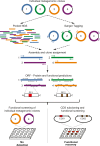Recovery and functional validation of hidden soil enzymes in metagenomic libraries
- PMID: 30851083
- PMCID: PMC6460280
- DOI: 10.1002/mbo3.572
Recovery and functional validation of hidden soil enzymes in metagenomic libraries
Abstract
The vast microbial diversity on the planet represents an invaluable source for identifying novel activities with potential industrial and therapeutic application. In this regard, metagenomics has emerged as a group of strategies that have significantly facilitated the analysis of DNA from multiple environments and has expanded the limits of known microbial diversity. However, the functional characterization of enzymes, metabolites, and products encoded by diverse microbial genomes is limited by the inefficient heterologous expression of foreign genes. We have implemented a pipeline that combines NGS and Sanger sequencing as a way to identify fosmids within metagenomic libraries. This strategy facilitated the identification of putative proteins, subcloning of targeted genes and preliminary characterization of selected proteins. Overall, the in silico approach followed by the experimental validation allowed us to efficiently recover the activity of previously hidden enzymes derived from agricultural soil samples. Therefore, the methodology workflow described herein can be applied to recover activities encoded by environmental DNA from multiple sources.
Keywords: Environmental microbiology; Functional genomics; Metagenomics; Microbial genomics.
© 2019 The Authors. MicrobiologyOpen published by John Wiley & Sons Ltd.
Conflict of interest statement
None declared.
Figures




Similar articles
-
A novel salt-tolerant chitobiosidase discovered by genetic screening of a metagenomic library derived from chitin-amended agricultural soil.Appl Microbiol Biotechnol. 2015 Oct;99(19):8199-215. doi: 10.1007/s00253-015-6639-5. Epub 2015 Jun 4. Appl Microbiol Biotechnol. 2015. PMID: 26040993 Free PMC article.
-
Ultrahigh-throughput discovery of promiscuous enzymes by picodroplet functional metagenomics.Nat Commun. 2015 Dec 7;6:10008. doi: 10.1038/ncomms10008. Nat Commun. 2015. PMID: 26639611 Free PMC article.
-
Multisubstrate isotope labeling and metagenomic analysis of active soil bacterial communities.mBio. 2014 Jul 15;5(4):e01157-14. doi: 10.1128/mBio.01157-14. mBio. 2014. PMID: 25028422 Free PMC article.
-
High-throughput metagenomic technologies for complex microbial community analysis: open and closed formats.mBio. 2015 Jan 27;6(1):e02288-14. doi: 10.1128/mBio.02288-14. mBio. 2015. PMID: 25626903 Free PMC article. Review.
-
Achievements and new knowledge unraveled by metagenomic approaches.Appl Microbiol Biotechnol. 2009 Nov;85(2):265-76. doi: 10.1007/s00253-009-2233-z. Epub 2009 Sep 16. Appl Microbiol Biotechnol. 2009. PMID: 19760178 Free PMC article. Review.
Cited by
-
Discovery of Novel Biosynthetic Gene Cluster Diversity From a Soil Metagenomic Library.Front Microbiol. 2020 Dec 7;11:585398. doi: 10.3389/fmicb.2020.585398. eCollection 2020. Front Microbiol. 2020. PMID: 33365020 Free PMC article.
-
Emerging priorities for microbial metagenome research.Bioresour Technol Rep. 2020 Sep;11:100485. doi: 10.1016/j.biteb.2020.100485. Epub 2020 Jun 27. Bioresour Technol Rep. 2020. PMID: 32835181 Free PMC article. Review.
-
Potential Use of Microbial Community Genomes in Various Dimensions of Agriculture Productivity and Its Management: A Review.Front Microbiol. 2022 May 17;13:708335. doi: 10.3389/fmicb.2022.708335. eCollection 2022. Front Microbiol. 2022. PMID: 35655999 Free PMC article. Review.
References
Publication types
MeSH terms
Substances
Associated data
- Actions
LinkOut - more resources
Full Text Sources

